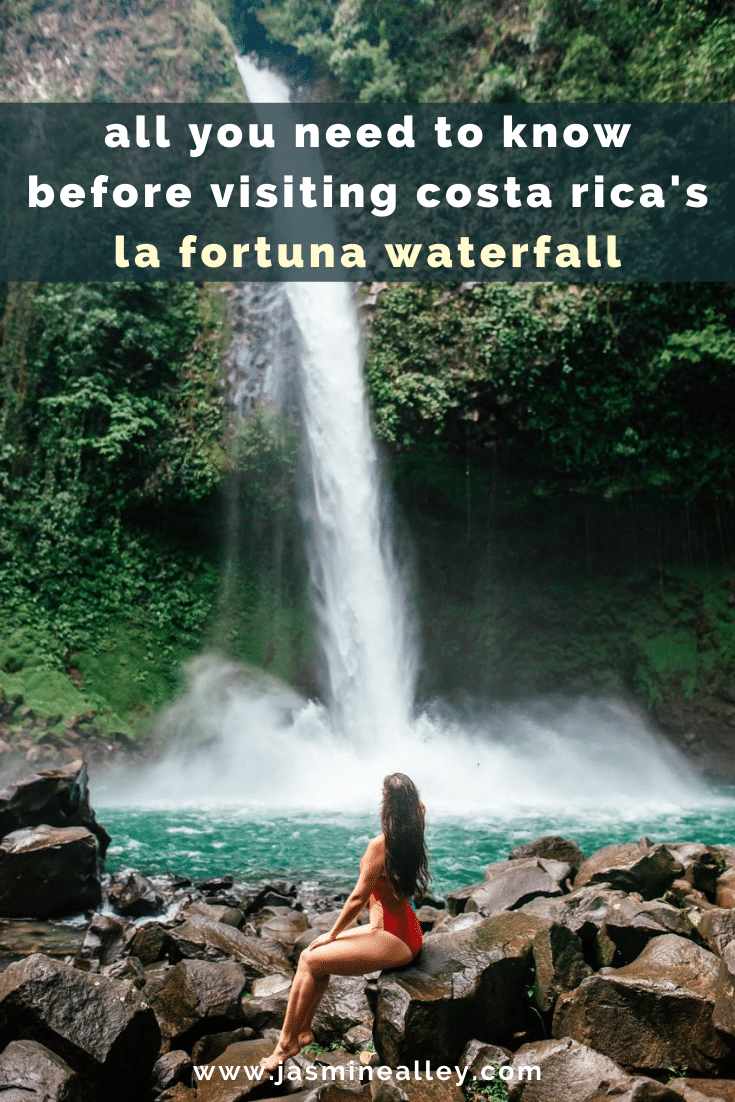
For such a small country, Costa Rica has an abundance of natural wonders, La Fortuna waterfall being one of them!
The Costa Rican landscape is unique, with a variety of topography and geographic features.
You’ll find lakes, mountains, volcanos, hot springs, beaches, and, of course, waterfalls!
While no official count of the total number of waterfalls exists, it is safe to venture a guess that the number is in the hundreds.
There are so many great waterfalls to see, but I think La Fortuna tops them all! Why the bold claim? Well, due to its location, ease of access, and sheer beauty!
After visiting and seeing it for myself, I decided to put together a complete guide for visiting La Fortuna Waterfall.
Here I’ll include how to get there, when to visit, and what to expect. I’ll also talk a bit about the surrounding area because it is simply beautiful. And read until the end to learn the waterfall’s context in the history of ecotourism in Costa Rica!
Where is La Fortuna waterfall?
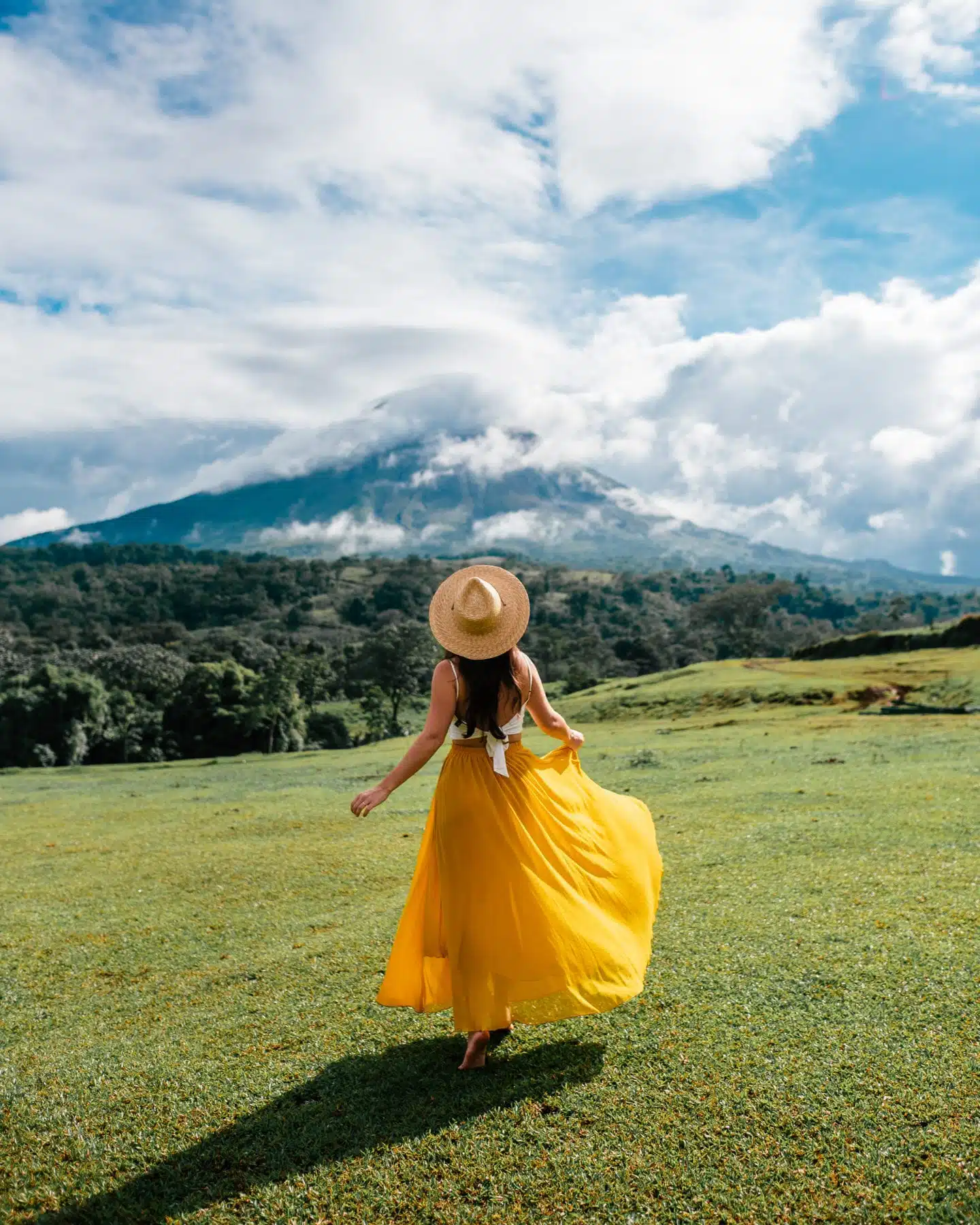
The waterfall is located four miles south of the town of La Fortuna, in a 200 acre biological reserve. It is very close by to the Arenal Volcano, pictured above.
The waterfall is part of La Fortuna River which travels through the Tilaran mountain range and ends at the Penas Blancas River, but not before dropping 230 feet into a pool of emerald green water at the waterfall.
Thanks to ADIFORT, (Asociación de Desarollo de Fortuna), the area is incredibly well maintained. It includes amenities that you will not find at other waterfalls. Like what? Well, there’s a parking lot, souvenir shop, bathrooms, showers, and even a little cafe!
Getting to La Fortuna Waterfall

La Fortuna Waterfall is located in northwest Costa Rica. It is near Arenal Volcano National Park and four miles south of the town of La Fortuna. That being said, there are a few ways you might get there.
By car, taxi, or Uber
You can access the waterfall by car, with ample parking in the lot adjacent to the entrance to the falls. That is how we got to La Fortuna, and it was quick and easy. The road was just fine for our small little rental sedan.
You can also arrange for a taxi to and from the falls for $10 USD on a one way trip from the nearby town. Just be sure to arrange a return service at a scheduled time.
Of course, if you have access to internet service, just request an Uber. Though you may need to wait a bit longer than you are used to, the service is available in the La Fortuna area.
Booking a tour
A tour is not necessary in my opinion- especially if you have your own car. But if you prefer to explore new places via tours, there are several options for you.
There are countless tours available to the falls ranging from horseback to ATVs and even hiking tours. Knowledgeable guides will teach you about the region’s history in addition to facts about the area’s flora and fauna. Then you’ll have time to enjoy the waterfall at your own pace.
Depending on the tour company, your guide will likely provide pick-up and drop-off services from your lodging. That makes the trip to the waterfall simple and educational.
Walking from downtown La Fortuna
Should you choose to walk from downtown La Fortuna, it is possible!
However, it will take you over an hour to make the journey. We saw people walking down the long road to the entrance and I was impressed! Just remember that you will still need to hike through the rainforest to make your way to the base of the waterfall, but that’s all part of the fun!
From San Jose or Liberia
To get to La Fortuna from the larger cities of San Jose or Liberia, expect about a three-hour drive.
A day trip will significantly limit your time at the falls and will mostly consist of driving. As such, I recommend staying somewhere in La Fortuna during your visit. (More on that later).
The drive from San Jose is 80 miles and will take you down the Panamericana Highway through San Ramon. At San Ramon, you will rake Route 702 through several villages before arriving at your destination in La Fortuna.
Grab some water and a snack before driving another four miles to the waterfall. If you arrive later in the day, the lot might be full, so definitely plan ahead!
If you are driving from Liberia, the drive will take the same amount of time. You will need to take the Panamerica Highway through Canas and turn left on Road 142 before arriving at La Fortuna.
The hike to La Fortuna Waterfall
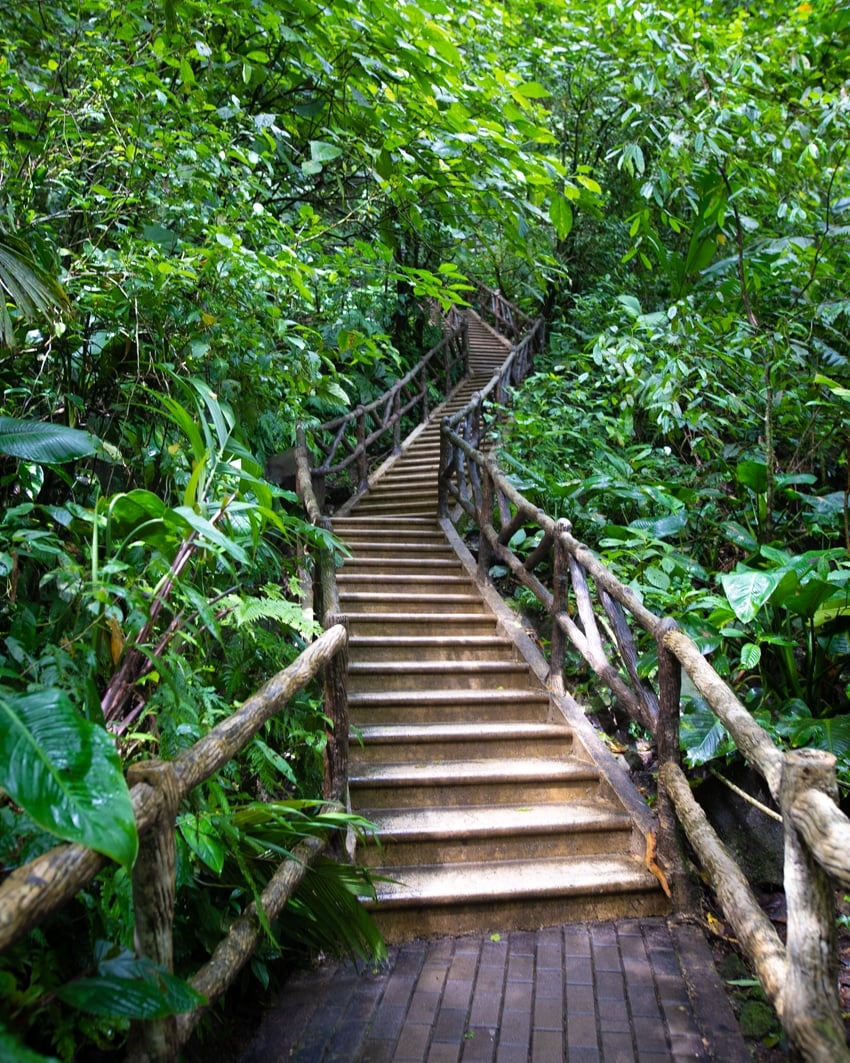
All things considered, the hike to the waterfall is simple and not too long. The majority of it is going down a very long staircase.
But first things first: you’ve pulled into the parking lot and now it’s time to pay your entrance fees.
Hours & entrance fees
Hours of operation are 7:30am to 4:00pm daily. You will need to pay an entrance fee to see La Fortuna, which costs $18 USD for adults and $5 for children 8 and under.
If you book a private tour, that will include the park’s entrance fee.
You’ll get a wrist band that proves you paid, then you’ll walk around the ticketing area and go through a gate. Now it’s time to start your hike!
The hike to the falls
It may be a good idea to do a bit of walking ahead of your visit because the trail, while fairly short, has hundreds of steps for you to navigate.
The walk to the waterfall is in a merciful downward trajectory. The ADIFORT association has ensured that the hike is safe for mobile people of all ages and athletic abilities. Handrails throughout the walk and benches dotting the trail help you to catch your breath if you need to.
Going down is pretty easy. It’s going back up that is quite the doozy!
There are over 500 steps to get to the falls so try to save some energy for the trip back. It should take you approximately 15 minutes to get down and double that amount of time to get back up since you’re fighting gravity. Hold onto the railing and be sure to take breaks if you start to feel tired or faint!
You made it to the falls!

… and so did everyone else.
Don’t worry, even if there are a lot of people there, the crowds ebb and flow. You’re bound to find a good spot to enjoy the falls and take a photo!
Once you reach the base of the waterfall, you have free rein to walk around the area along the rocky shore or swim in the water.
The powerful waterfall makes it challenging to swim into the middle of the pool so, for safety sake, stay closer to the rocks. I recommend bringing water shoes for some extra traction as the rocks do get slippery due to the mistiness.
The waterfall is loud and roaring, covering everything and everyone in its vicinity in a coating of fresh mist. The water drops like a spout from a large rocky overhang that is covered in lush green trees, vines, and other dense plants. In the dry season, the water is lower and makes for safer swimming near the coursing waters.
The water alternates colors depending on the weather, from emerald green to crystal clear with shades of blue.
When you have had your fill of waterfall, you will make your way back up the 500 hundred steps and exit through the souvenir shop to the parking lot.
The viewing platform
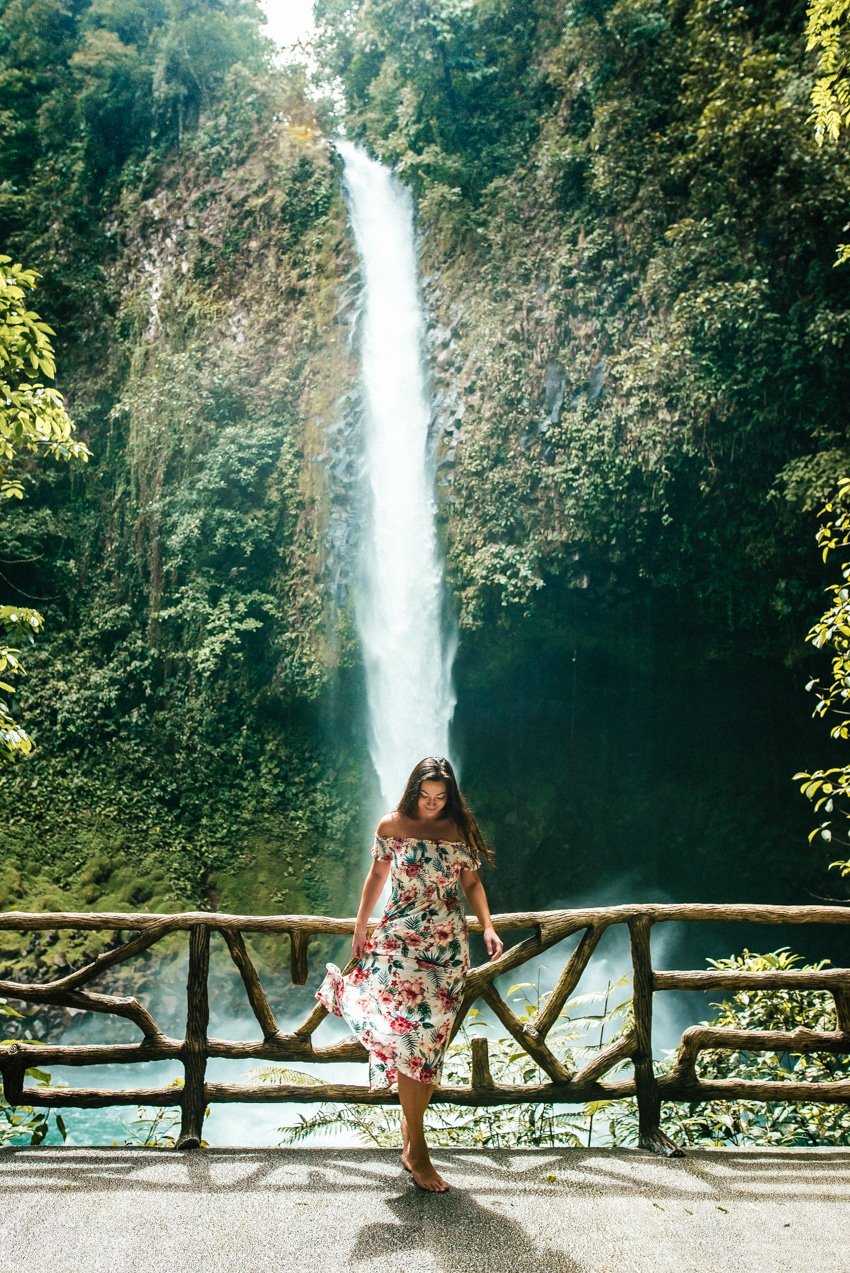
There is also a viewing platform where you can see the falls from a bit higher up.
If you’re a photographer like me, you’ll appreciate how you can capture different angles of the falls. The falls from the platform are framed nicely by the trees on the edges and the pretty wooden railing.
The downstream swimming area
Like I mentioned before, the water under the falls can get pretty choppy. As such, you might be worried about swimming there. But don’t worry! There’s another great place to swim just around the corner!
If you go downstream of the falls, you’ll see the area filmed in the video above. The water is a beautiful shade of blue, much calmer, and perfect for cooling off.
Wildlife in the area
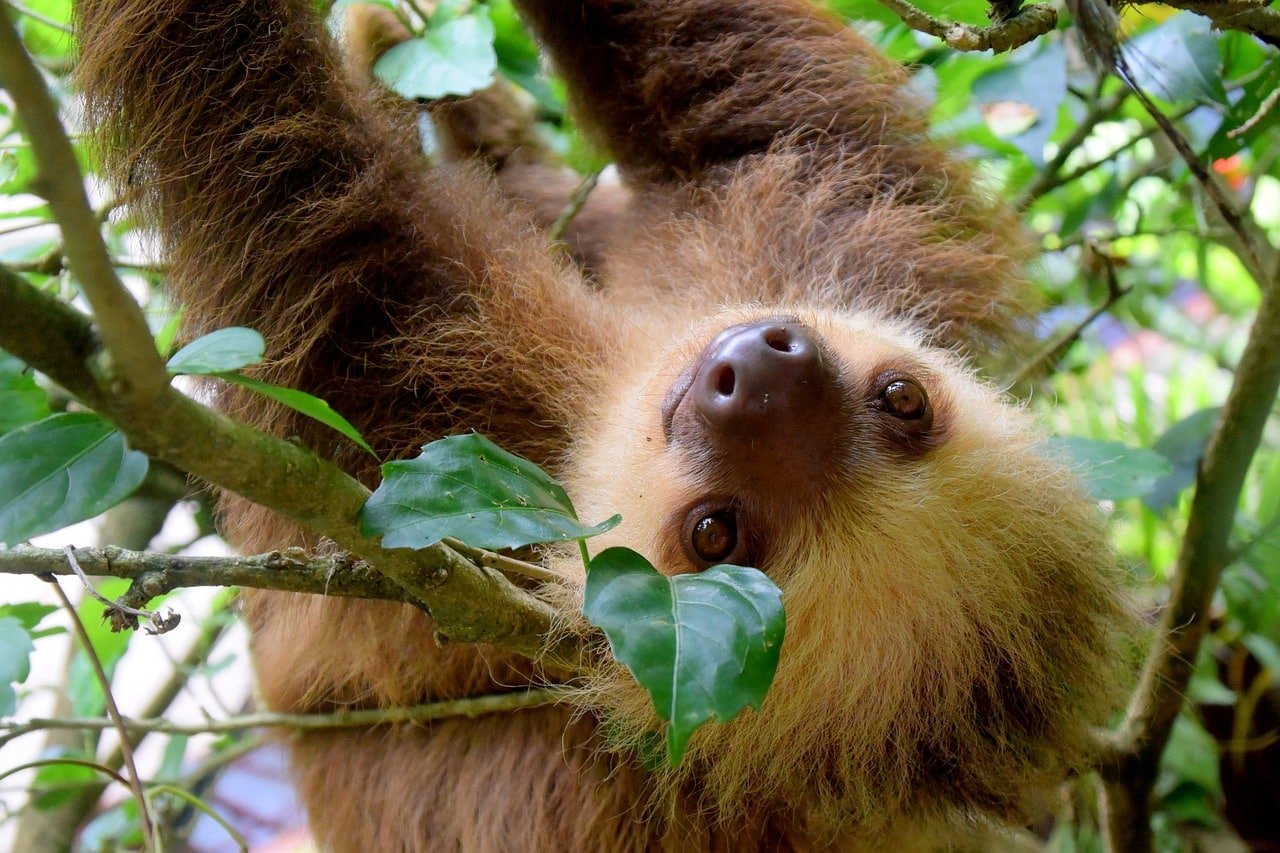
La Fortuna is also a great place to observe wildlife and plant life. The biodiversity is rich in the tropical rainforest that surrounds La Fortuna and nearby Arenal Volcano National Park.
There are over 12,000 species of plants in Costa Rica, most of which are found in the rainforests. Tree species such as cedar, fig, balsa, yos, and ceiba can be found in abundance in La Fortuna.
Be sure to bring your camera to capture all the great critters that call La Fortuna home. The Arenal area is home to plenty of birds, mammals, and reptiles.
On your hike to La Fortuna Waterfall, you keep a sharp eye out! You might spot a toucan, sloths, white-nose coati, capuchin monkeys, and all kinds of lizards, frogs, and snakes (it is Costa Rica, after all!). Jaguars and deer call this area home, though it’s highly unlikely that you’d encounter these creatures.
When we visited, I’ll be honest… the only things I saw were bugs!
Is it safe to visit?

I visited La Fortuna waterfall with my friend Angie. As two girls road tripping around Costa Rica, we felt perfectly safe!
We had our expensive camera gear near us on the rocks and kept an eye on it while taking photos.
Of course, make sure you’re smart about locking your car and hiding your valuables. But this area is so well maintained that you should have no issues!
Heading to Costa Rica? Check out my list of the 41 most beautiful places in Costa Rica!
When to visit La Fortuna
For all intents and purposes, there are two seasons in La Fortuna that you should know about. The rainy season is from May to November and the dry season is from December to April.
As you can imagine, it is much easier to hike in the dry season. The trails are less muddy, though there is no guarantee that a tropical rain shower won’t spoil your day in the dry times.
Temperatures hover in the mid-70s but can drop to the mid-40s at night. Typically you are bound to have some sunshine no matter when you visit the area.
Where to Stay

If you do stay overnight, there are so many awesome places to rent that have hot springs! There are many hot springs in the area, heated by the Arenal volcano.
We flew into Liberia and journeyed to La Fortuna for a night, and stayed at the Arenal Kioro Suites & Spa.
I actually recommend staying more than one night if you want to see the Arenal volcano because of the weather.
We got lucky and saw the Arenal volcano right before leaving La Fortuna! The clouds parted and there she was in all her glory!
You can find your accommodation in the La Fortuna area by searching here:
Booking.comThe History of La Fortuna

The town of La Fortuna is the home base for anyone visiting La Fortuna Waterfall and the Arenal Volcano.
The town was settled in the 1930s, but didn’t experience substantial growth until the arrival of ecotourists to the area.
Since the late 1970s and early 1980s, it has grown to include many businesses such as hot springs, resorts, and adventure excursion companies. Popular activities here include whitewater rafting, zip-lining, bungee jumping, and canyoneering.
La Fortuna avoided a crisis when the Arenal Volcano erupted in the late 1960s, causing damage to the region and resulting in the deaths of over 80 people.
Thankfully, the town was spared. In a bit of irony, it began to grow along with interest in the active volcano.
With visitors flocking to the area, La Fortuna Waterfall gained the attention of travelers from faraway lands. It became a prized destination on tourist itineraries.
La Fortuna Waterfall is known by several names, and it is important to remember a few of them as signs, tourism pamphlets, websites, and GPS labels can vary. It has been called Fortuna River Waterfall, Rio Fortuna Waterfall, Catarata La Fortuna, and Fortune Waterfall.
It is one of the most popular places to visit in Costa Rica and a top contender for best waterfall in the country. As such, the area near the town of La Fortuna around the Arenal Volcano can get a bit crowded.
Ecotourism in Costa Rica
Ecotourism is an important part of Costa Rica’s economy and culture. You may be surprised to learn that protected lands and reserves occupy over a quarter of the country’s landmass. To put that into perspective, that’s larger than the entirety of the nations of Jamaica or Qatar!
As a result, there is some pretty fascinating history intertwined with ecotourism!
Before visitors began arriving, Costa Rica was a destination for biologists to observe and learn about the untouched rainforests of the country. Biologists were looking for a way to study the rainforest without disturbing the land. They also wanted to also observe the canopy where nearly 40% of all life on earth exists.
Enter Donald Perry, an American biology student. He’s credited as being the inventor of zip lining due to his work in the canopies of the Costa Rican rainforests!
He devised a way to explore the canopy without disturbing the flora or fauna by using a crossbow! He would shoot climbable ropes between the trees and use mountaineering equipment to make his way between them.
Since then, zip lining has made it to the big leagues and Costa Rica. It has become a welcoming destination for adventurers and ecotourists to participate in the practice of learning about the rainforest, landscape, and wildlife of the country.
However, it would be impractical to see Costa Rica from the canopy alone. As you’d expect, much of the exploration is done on the ground.
Seeing the economic opportunity and need for preservation of the natural wonders of Costa Rica, federal and local governments got to work. They began organizing associations that would be in charge of overseeing their respective areas and the natural destinations within them.
Preserving the waterfall
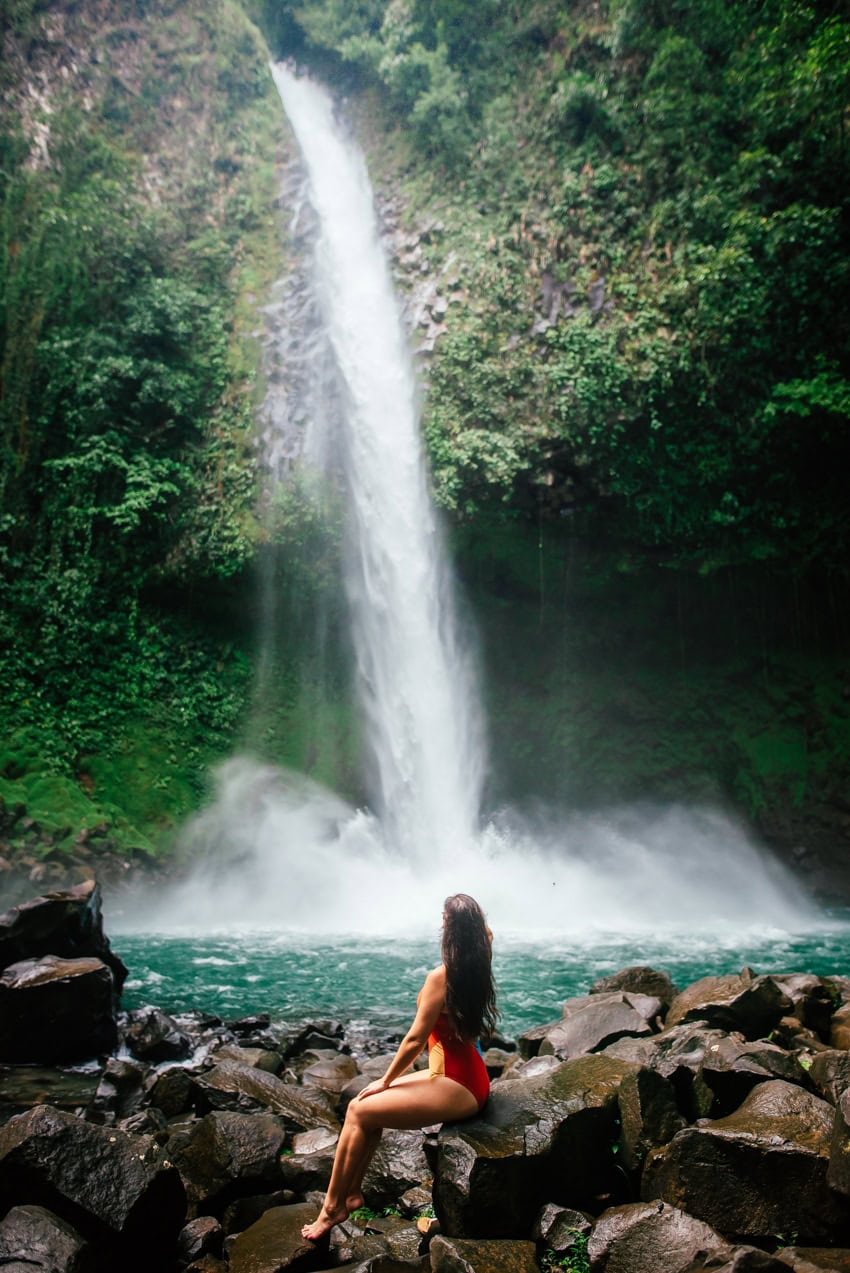
ADIFORT (Asociación de Desarollo de Fortuna), or the Integral Development Association of La Fortuna, oversees La Fortuna Waterfall.
The association ensures that tourist activity does not spoil La Fortuna waterfall. They are responsible for promoting development projects in the La Fortuna community to improve infrastructure and its beautification. It’s a result of those ecotourism dollars- money well spent if you ask me!
As ecotourism grew, so did the development of areas that would have been considered wild and unexplored. Before La Fortuna Waterfall was a staple on tourist itineraries, it was hidden among the lush trees in the Costa Rican rainforest. That is, until the official founding of the town of La Fortuna, which today is home to nearly 20,000 Costa Ricans and expats.
I’m so glad we get to see its beauty, but let’s make sure we heed any signs put in place and respect the earth.
In conclusion…
Of the dozens, if not hundred, of waterfalls in Costa Rica, La Fortuna is an absolute gem. It might not be the tallest or most secluded, but it is a stunning marvel! Truly a testament to the sheer beauty of the Costa Rican landscape.
If you have more time in your day, be sure to visit nearby Arenal Volcano National Park. Here you’ll find the active volcano that started it all!
And of course, don’t miss the hot springs in the area! They’ll be a welcome treat for those aching leg muscles after your 1000-step climb to and from La Fortuna Waterfall.
If you have any questions about visiting La Fortuna waterfall, leave them in the comments!
And if you’re planning to visit Costa Rica one of these days, check out the 41 most beautiful places in Costa Rica!
Safe travels!
Jasmine
PS. If you found this post helpful, please share it to Pinterest! You can use one of the images below for easy pinning!
